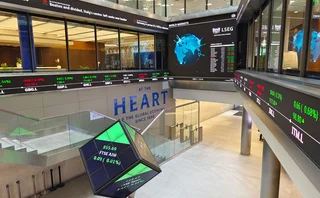
Flow market-maker of the year: Natixis
Risk Awards 2025: Flow push pays off, with FX and rates volumes almost doubling year-on-year

This year’s winner is not a giant in electronic market-making, and it doesn’t aim to be – Natixis is a heavyweight in structured and solutions trading that concluded it was not punching its weight in the flow space, and decided to change that.
The scale of the investment required – a big jump in technology spend allocated to flow, a flood of new hires, a steady ratcheting up of risk limits – illustrates how hard it now is to become relevant in a business that has become ever-more sophisticated in the past decade. The resulting jump in client numbers, volumes and revenues also shows how significant the payoff can be.
Michael Haize, global head of markets with Natixis, acknowledges the long-term commitment that has been required, but says the foundations were already in place.
“At the end of the day, the factory and the building blocks were there; we were just not exploiting them,” he says.

The journey began in the middle of 2020, when the firm started work on a three-year plan that would take it through to the end of this year.
Haize says the decision to beef up flow had both an offensive and a defensive argument. In 2020, Natixis had seen other banks – with stronger flow capabilities – benefiting as a jump in volatility created more flow business. The French bank’s structured and solutions desks found the environment harder to navigate.
“It was not our best year ever, contrary to many of the flow banks. So, the idea was that this flow business is a business where we can be long volatility and benefit from the market movements and from heightened risk,” says Haize.
Since then, the rapid run-up in interest rates – followed by diverging conditions and expectations – have created the perfect environment for a growing flow business to prove its worth.
Within foreign exchange, Natixis has seen trading volumes jump 264% from 2021 to 2024, with 92% growth year-on-year. The story is even better in rates, where volumes have soared by 442% over three years, and by 83% since last year.
And there is no stopping here. By 2030, the new goal is to grow the bank’s revenues across both flow and solutions businesses by circa 50%.
Going with the flow
The flow build-out started with human capital. Hires arrived in Paris, the Americas and Asia, covering euro interest rate swaps, vanilla interest rate options, US Treasuries, and government bonds. Hedge fund and real money sales staff were added across all three regions, along with dedicated technology ‘commandos’ for flow trading.
“We had a real focus on developing both the trading and sales staff. Overall, 12% of our staff this year are new hires. And if you look only at rates and currencies business lines over the last two years, 35% of our staff are new recruits,” says Pascal Amiel, global co-head of macro markets at Natixis.
To create the capacity all of the hoped-for business would require, Natixis hiked its global value-at-risk limit by 10% in each of the two most recent years.
All of this work has allowed us to continue to do business with specific counterparties, even when we were facing some limited capacity
Pascal Amiel, Natixis
This has been noticed.
“They have definitely demonstrated enhanced risk warehousing, because they can show axes and reliable pricing in times of volatility, and they can trade sizes that are quite big. So, I can imagine that they could manage risks that are bigger than before,” says a trader at a European rates trading client that reports a 50% increase in volumes with Natixis in 2024.
Amiel notes that the support cannot stop here if the bank wants to keep growing flow revenues. It is already planning to hike its risk appetite, so it can cope with larger trades.
It’s not just about market risk, of course. Amiel says the bank has worked hard on dynamic management of counterparty risk to create more trading capacity. This involves a range of interest rate, FX and other hedges to mitigate market exposure – one of the inputs to credit valuation adjustment – as well as buying credit protection via single-name and index credit default swaps.
The bank has also used the credit insurance market to shed some of its exposure.
“All of this work has allowed us to continue to do business with specific counterparties, even when we were facing some limited capacity,” notes Amiel.
Bigger is better
The strategy has worked like a charm.
Since 2021, Natixis has added around 2,300 new clients, roughly half of which are trading flow products. This year has seen a 23% increase in clients onboarded within global markets.
The influx has been led by hedge funds and asset managers, with volumes from these client segments growing fourfold year-on-year. The bank has also made inroads with corporate clients, which have increased the amount of FX spot and options they trade with Natixis by 70% and 320% since 2021.

Diversifying the client base has allowed the bank to recycle more of its risk internally, further increasing capacity. “We want to bring hedge fund clients liquidity, and at the same time we needed the capacity to recycle risk with them – specifically, the risk coming from corporates and insurance companies. And that’s working well,” says Amiel.
None of this would be possible without a huge investment in technology. Roughly half the bank’s IT budget for 2024 was directed to flow projects, compared with just 10% in 2021. Much of that has been spent on revamping and modernising e-trading capabilities. Natixis built a new graphical interface for clients using the latest architecture and web technologies. Pricing and hedging algorithms for rates and foreign exchange have been upgraded with additional features, such as embedded XVA charges, automated monitoring of central bank meetings and dynamic spreads based on size and time.
That last feature – which also factors in the client’s standing within the firm – has allowed Natixis to increase the size it quotes in foreign exchange markets.
“Depending on the time of the day, some currencies are going to be deemed much more liquid on some platforms,” says Valery Gombert, global co-head of macro markets at Natixis. “So, depending on the time of the day, we’re going to adjust the spread plus adjust by the tiering of the client and the size of the request.”
Gombert says the new algos are part of a broader effort to provide liquidity in significantly larger size. “It’s an internal challenge to raise the bar of the size we can offer on every single product,” he says. “The bigger size we can quote automatically the better.”
Internalisation has been another big area of focus for Natixis, allowing it to keep a lid on market impact and brokerage costs even as volumes grow. The 92% increase in year-on-year foreign exchange volumes, for instance, has resulted in just a 2% increase in brokerage fees.
Gombert says the ability to offset the bulk of client flows, coupled with increased risk limits and cutting-edge hedging tools, means the firm is well-equipped to handle even higher volumes: “We have a lot of tools to either match the risk or mitigate it at inception or very early in the trade, and to then slowly but surely unwind in a more definite fashion.”
Only users who have a paid subscription or are part of a corporate subscription are able to print or copy content.
To access these options, along with all other subscription benefits, please contact info@risk.net or view our subscription options here: http://subscriptions.risk.net/subscribe
You are currently unable to print this content. Please contact info@risk.net to find out more.
You are currently unable to copy this content. Please contact info@risk.net to find out more.
Copyright Infopro Digital Limited. All rights reserved.
As outlined in our terms and conditions, https://www.infopro-digital.com/terms-and-conditions/subscriptions/ (point 2.4), printing is limited to a single copy.
If you would like to purchase additional rights please email info@risk.net
Copyright Infopro Digital Limited. All rights reserved.
You may share this content using our article tools. As outlined in our terms and conditions, https://www.infopro-digital.com/terms-and-conditions/subscriptions/ (clause 2.4), an Authorised User may only make one copy of the materials for their own personal use. You must also comply with the restrictions in clause 2.5.
If you would like to purchase additional rights please email info@risk.net
More on Awards
Clearing house of the year: LCH
Risk Awards 2025: LCH outshines rivals in its commitment to innovation and co-operation with clearing members
Best use of machine learning/AI: CompatibL
CompatibL’s groundbreaking use of LLMs for automated trade entry earned the Best use of machine learning/AI award at the 2025 Risk Markets Technology Awards, redefining speed and reliability in what-if analytics
Markets Technology Awards 2025 winners’ review
Vendors jockeying for position in this year’s MTAs, as banks and regulators take aim at counterparty blind spots
Equity derivatives house of the year: Bank of America
Risk Awards 2025: Bank gains plaudits – and profits – with enhanced product range, including new variants of short-vol structures and equity dispersion
Law firm of the year: Linklaters
Risk Awards 2025: Law firm’s work helped buttress markets for credit derivatives, clearing and digital assets
Derivatives house of the year: UBS
Risk Awards 2025: Mega-merger expected to add $1 billion to markets revenues, via 30 integration projects
Interest rate derivatives house of the year: JP Morgan
Risk Awards 2025: Steepener hedges and Spire novations helped clients navigate shifting rates regime
Currency derivatives house of the year: UBS
Risk Awards 2025: Access to wealth management client base helped Swiss bank to recycle volatility and provide accurate pricing for a range of FX structures








